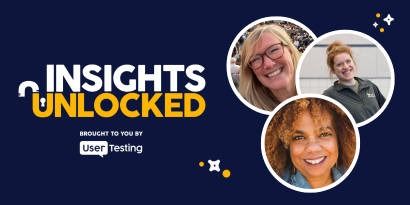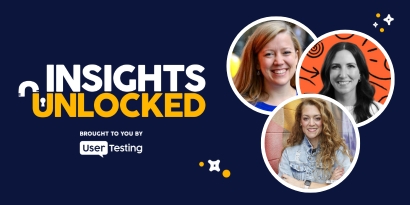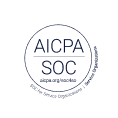
Episode 10 | April 05, 2021
Designing User-Centric Education: Insights from Raina Mehta
Explore how Raina Mehta of Kaplan designs user-centric digital experiences in education, focusing on personalization, UX, and the future of online learning.
Designing User-Centric Education: Insights from Raina Mehta
In today’s rapidly evolving digital landscape, creating educational experiences that are both engaging and effective has become more challenging—and more critical—than ever before. Raina Mehta, Head of Product and User Experience at Kaplan, offers a unique perspective on this topic, blending her extensive experience with a deep commitment to user-centric design. In a recent episode of Insights Unlocked, Raina shares invaluable insights on how to design digital educational experiences that truly resonate with learners.
The power of user-centric design in education
When it comes to educational technology, the user experience can make or break a product. As Raina explains, “A great feature set without a great user experience will eventually lose to the competition.” This sentiment highlights the importance of not only what a product does but how it feels to the user. Educational platforms must be intuitive, accessible, and, above all, designed with the learner's needs in mind.
“A great feature set without a great user experience will eventually lose to the competition.” —Raina Mehta
Raina’s approach to user-centric design is rooted in understanding the common pain points of students and addressing them head-on. For example, Kaplan’s digital transformation efforts have focused on personalizing the learning journey to reduce the overwhelming nature of extensive coursework. “We have some courses with over 600 modules,” she notes, “and that's really overwhelming for students. So giving them a way to understand and identify their strengths and weaknesses helps us personalize the experience for them.”
Personalization as the key to engagement
One of the standout themes in Raina’s discussion is the importance of personalization in digital education. In an age where students are accustomed to tailored experiences in nearly every aspect of their lives, the expectation for personalized learning paths is higher than ever. “Students want to feel just like they interact with a teacher who understands them,” Raina explains. “The technology is there today. We can do that with a sound platform.”
Personalization not only enhances the learning experience but also boosts engagement. By tailoring content to meet the individual needs of students, educational platforms can keep learners motivated and on track, even when navigating through extensive material. “It’s about helping students achieve their educational outcomes in the most efficient way possible,” says Raina.

The impact of COVID-19 on online education
The COVID-19 pandemic has accelerated the shift towards online education, bringing both opportunities and challenges. Raina acknowledges this shift, stating, “The dynamics you've seen playing out over the last several years were already in motion, but COVID accelerated that shift.”
“The dynamics you've seen playing out over the last several years were already in motion, but COVID accelerated that shift.”
As more students and educators move online, the demand for high-quality, user-friendly educational platforms has skyrocketed. This shift has underscored the need for platforms that are not only effective in delivering content but also in fostering a sense of community and support among students. “How do you help students feel like they're not isolated?” Raina asks. “Providing social-emotional support and peer-to-peer collaboration is crucial in an online environment.”
Embracing lean UX and design thinking
Raina’s experience spans various industries, but one constant is her commitment to Lean UX and design thinking principles. These methodologies, which emphasize rapid prototyping, user feedback, and iterative design, are particularly well-suited to the fast-paced world of digital education. “I’m a big proponent of design thinking, but with the caveat that you’ve got to have speed behind it,” she shares.
At Kaplan, these principles have been integral to the company’s digital transformation efforts. By prioritizing user feedback and continuous improvement, Raina and her team have been able to create educational products that are not only innovative but also deeply aligned with the needs of students.
The future of digital education
Looking ahead, Raina is optimistic about the future of digital education, particularly in how technology will continue to enhance the learning experience. She points out the potential of the Internet of Things (IoT) in creating more integrated and seamless educational environments. “Right now, it feels like a very fragmented ecosystem,” she says, “but I’m really interested to see how things become more unified across different platforms.”
As digital natives become the primary consumers of educational content, the demand for personalized, user-friendly experiences will only grow. Raina’s work at Kaplan is a testament to the power of user-centric design in meeting this demand and setting a new standard for what digital education can achieve.
Raina Mehta’s insights offer a valuable roadmap for anyone involved in designing digital educational products. By prioritizing user experience, embracing personalization, and staying agile through Lean UX practices, educators and product designers alike can create powerful learning tools that not only meet but exceed the expectations of today’s learners. As the landscape of education continues to evolve, the principles shared by Raina will undoubtedly play a crucial role in shaping its future.
Episode Links:
- Digital personalization and user experience
Learn how to offer tailored experiences across digital channels, which is crucial for engaging and retaining users. This aligns with Raina's emphasis on personalization in educational platforms. - The ultimate guide to user-centric product design
This guide covers the principles of user-centric design, emphasizing the importance of understanding user needs and iterating based on feedback—core ideas Raina highlights in her approach to digital education. - Building better digital products
This resource discusses how digital product teams can use customer insights to build better products, which resonates with Raina’s focus on integrating user feedback into the design process. - Reinventing work through digital transformation
Discusses the broader impact of digital transformation, including how it changes the way teams collaborate—a topic that ties into the shifts Raina describes in the educational space.










